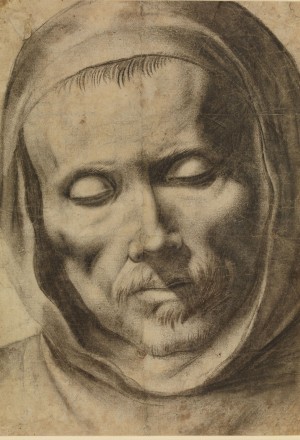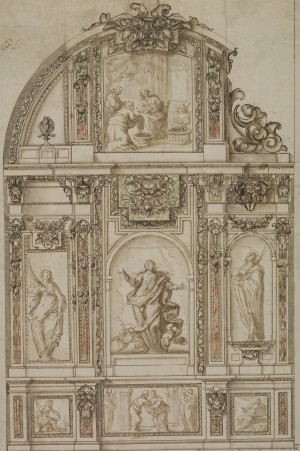
Francisco Goya, Sleep of Reason
Rare Prints and Drawings from Spain in Santa Fe
Organized by the British Museum in 2012, and seen previously at Museo Nacional del Prado in Madrid and the Art Gallery of New South Wales in Sydney, Australia, Renaissance to Goya: Prints and Drawings from Spain debuted on December 15 at the New Mexico Museum of Art, Santa Fe, the show’s only US venue (through March 9).
In the exhibition catalog, Mark P. McDonald, the British Museum’s curator of Old Master Prints and Spanish Drawings, explains that the show’s curatorial premise was both to introduce audiences to the range of Spanish graphic arts and to dispel the myth that drawing and printmaking are lesser practices in the history of European art. In spite of the outsized role that Spain and her cultural heritage plays in northern New Mexico, Iberian arts occupy a tiny niche in the canon of western art. Likewise, drawings are a rarefied collecting area and exhibition focus. Santa Fe is fortunate to get this exhibition, which would be far more likely to appear at National Gallery of Art in Washington, DC or at New York’s Metropolitan Museum of Art or Morgan Library and Museum, collections with deep holdings in drawings.
The exhibition of 132 works surveys two and a half centuries of Spanish graphic arts, from the mid-sixteenth century until the death of Francisco Goya in 1828. The time span also coincides with key moments in western art history, especially the spread of Renaissance ideas from Italy throughout Europe, and the successive development of reproductive practices like etching, engraving, aquatint, and lithography that revolutionized art practice from the sixteenth through the late eighteenth centuries.
As McDonald notes, apart from Goya, Spanish graphic arts are poorly known, even among drawing enthusiasts, because so few survive. Italy, not Spain, was the center of the culture that produced large quantities of finished drawings, where students and collectors fought over drawings by masters like Michelangelo and Raphael. Italy also saw the proliferation of a kind of art instruction in painting, sculpture, and even architecture, where drawing was essential, a phenomenon that culminated in the foundation of professional art academies in the fifteenth and sixteenth centuries. The Real Academia de Bellas Artes de San Fernando in Madrid was not founded until 1744.
Spanish drawings also differ from their continental neighbors in medium, format, finish, and subject matter. They tend to be executed in pen and ink, on smaller sheets of paper, and often appear unfinished. And perhaps in an acknowledgement of the nature of Spanish patronage, most of the surviving drawings address religious themes; there are few portraits, nudes, landscapes, or scenes of everyday life.
There are only a few big names in the exhibition: Francisco de Zurbarán, José de Ribera, Bartolomé Esteban Murillo, and of course Diego Velázquez. This is partly the nature of the British Museum’s holdings, but is also due to the scarcity of Spanish drawings in general. While many Ribera and Murillo drawings survive, there are very few by Zurbarán or Velázquez. A drawing of two horses in the show is attributed to Velázquez by both style and typological resemblance to known works and the drawing of a pensive, or perhaps dead, monk is one of the few drawings securely attributed to the Sevillian master Zurbarán. The lack of works by famous artists in this show might be considered a detriment, but it has a liberating effect on the viewer, who may be less likely to scan the labels for “names” and more likely to focus on the works themselves.
The show is organized around geographic schools of artists: Castile, Madrid, Andalusia, Valencia and Naples, which was part of the Spanish empire during much of the period. Madrid dominates the story, as the seat of the Spanish monarchy from the 1560s, when Phillip II ceased his predecessors’ custom of moving the court around Spain. Philip and the Spanish monarchy were, along with the church, the primary art patrons in Spain, and their taste can be clearly observed in the nation’s surviving graphic arts. There are many studies for religious paintings, and for both ephemeral and permanent architectural assemblages. A superb mid-seventeenth century drawing by Sebastian de Herrera Barnuevo (1619-1671) shows his proposal for an unidentified — or perhaps never built — altarpiece, with the left and right sides offering the patron different choices for the Baroque ornamentation.
Francisco de Goya (1746-1828) has the largest number of works in the exhibition, as befits his status as the most prolific of Spanish graphic artists during the centuries surveyed here. Rather than simply celebrating Goya, McDonald situates his work critically, allowing viewers to better understand the historical and cultural contexts of print series that have taken on lives of their own: “La Tauromaquia,” the “Disasters of War,” and “Los Caprichos.” Printmaking in Spain was underdeveloped until the eighteenth century, partly because of the huge number of Italian and French prints imported into Iberia. Printmaking attained a measure of state support when it was included in the curriculum of the royal academy in the later eighteenth century. In 1789, the Spanish monarchy sponsored a program to promote the national painting collection through engraved reproductions. The exhibition shows two engravings of Velázquez’s 1628 “Triumph of Bacchus (The Drunkards),” which at the time was hanging in the royal palace. While Manuel Salvador Carmona’s version hews closely to Velázquez in all respects, Goya’s version freely interprets the merrymakers’ expressions.
Exhibitions of prints and drawings have a way of looking all the same on the wall from a certain distance, and the installation at the New Mexico Museum of Art is no exception to this generalization. The effect is mitigated by the use of different colors in the sections on each geographical or thematic focus. Perhaps in acknowledgement of Santa Fe’s Spanish-speaking population, the show has some Spanish language content, including a video interview with the curator. And before one enters the exhibition proper, the local curatorial team has added a few works to show how New Mexicans, from the late eighteenth century up to about 1850, consumed graphic arts, primarily devotional prints found as book illustrations or single framed objects.








